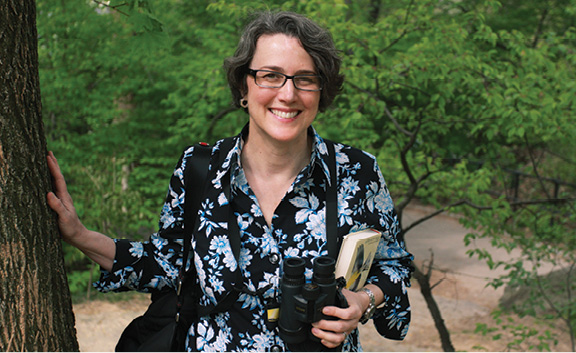
Round in his vivid yellow topcoat, white bars on his gray wings, the songbird hops in tree-limb shade in New York’s Central Park. It’s early spring, and Kellye Rosenheim, director of development at New York City Audubon, has a catch in her voice as she points him out—indicating where to catch a glimpse through a pair of high-powered binoculars.
“Pine warbler,” she says, noting the bird’s distinctive shape—rounded, though not as small as a chickadee or hummingbird—and his spring plumage. “He’s ready to breed; what can I say?”
Rosenheim and co-author Deborah Rivel are adept at spotting these little breeders—and hoppers and warblers—in and around the city. Since October 2013 they’ve used those skills to work on their book, Birdwatching in New York City and on Long Island, set to be published next year by University Presses of New England.
Rosenheim knows her birds. She focuses on fliers from the famous red-tailed hawks occupying a posh perch on Fifth Avenue to the marine fowl of Long Island estates and estuaries. For their book she and Rivel explored the parks of all five boroughs and Long Island. “I really had to learn a lot about both Staten Island and Long Island,” she says, noting that both have lesser-known green spaces. Long Island, for instance, has freshwater ponds and well-developed marine environments that host sea ducks.
Learning about avian life came late to Rosenheim. She began taking Nature Conservancy birding walks in Central Park in 1998, after moving to the nearby Upper West Side with her husband in 1992. In January 2015 she joined the staff of New York City Audubon, which champions the protection of wild birds and habitat in the city’s five boroughs, after spending years at a foundation that supported creative writing.
“I feel like bird-watching was sort of my destiny, in the same way you fall in love with someone and feel like it was meant to be,” Rosenheim says, while training her lenses on a brown creeper, a tiny egg-shaped brown bird that inches up the sides of equally brown trees, seeking out tiny insects. “Identifying birds just takes a little practice.”
Rosenheim’s nature awareness began on weekend visits as a child to her grandfather’s Louisiana fishing camp. He was “a great conservationist and environmentalist, though they didn’t call them that then”—and had a Teddy Roosevelt-like enthusiasm for land, without being too specific about its inhabitants. When she asked the names of birds, he would say, kindly, “Well, you don’t need to know the name of that bird. It’s not good to eat anyway.”
At Vanderbilt, Rosenheim thought of matters other than birds and their edibility. As an art history major, she learned to analyze, write and research. “It prepared me for anything that I wanted to do in life. The campus also had gorgeous trees, but my interest in nature then was zero,” she says.
Clearly, that’s no longer the case. Last year in March, Rosenheim and other birders escaped winter-stuffy apartments, then waited in Central Park for the appearance of a European goldfinch and its strikingly red face. “It was still cold, but I just had to get outside,” says Rosenheim. “We stood there and saw that bird, its red head shining in the sun. It was a great moment.”
—CATHERINE ARNOLD